| Article ID | Journal | Published Year | Pages | File Type |
|---|---|---|---|---|
| 10905650 | Experimental Cell Research | 2005 | 9 Pages |
Abstract
Mpv17-like protein (M-LP) has been identified as a new protein that shows high sequence homology with Mpv17 protein, a peroxisomal membrane protein involved in the development of early onset glomerulosclerosis. We previously showed that the originally identified M-LP isoform, designated M-LPL, is, like Mpv17, localized in peroxisomes, and that transfection with M-LPL up-regulates expression of the manganese superoxide dismutase (SOD2) gene [R. Iida, T. Yasuda, E. Tsubota, H. Takatsuka, M. Masuyama, T. Matsuki, K. Kishi, M-LP, Mpv17-like protein, has a peroxisomal membrane targeting signal comprising a transmembrane domain and a positively charged loop and up-regulates expression of the manganese superoxide dismutase gene. J. Biol. Chem. 278 (2003) 6301-6306.]. We report here the identification of a novel alternative splicing product of the M-LP gene, designated M-LPS. A comparison of the genomic sequence with the cDNA sequences and an analysis of 5'-flanking regions revealed that the two isoforms are generated by alternative usage of two promoters. M-LPS consists of the C-terminal half of M-LPL (90 amino acids) and therefore lacks the peroxisome targeting signal of membrane protein that exists near the N-terminus of M-LPL. Expression of green fluorescent protein-tagged M-LPS in COS-7 cells demonstrated that M-LPS localizes in the cytosol. In mice, M-LPS is expressed exclusively in kidneys after the age of 6 weeks. Moreover, quantitative real-time PCR analysis revealed that transfection with M-LPS up-regulates expression of the SOD2 gene and down-regulates expression of the cellular glutathione peroxidase (Gpx1) and plasma glutathione peroxidase (Gpx3) genes. Taken together, these results suggest different functional attributes of the two M-LP isoforms during aging and development.
Keywords
Related Topics
Life Sciences
Biochemistry, Genetics and Molecular Biology
Cancer Research
Authors
Reiko Iida, Toshihiro Yasuda, Etsuko Tsubota, Hisakazu Takatsuka, Mika Masuyama, Takasumi Matsuki, Koichiro Kishi,
